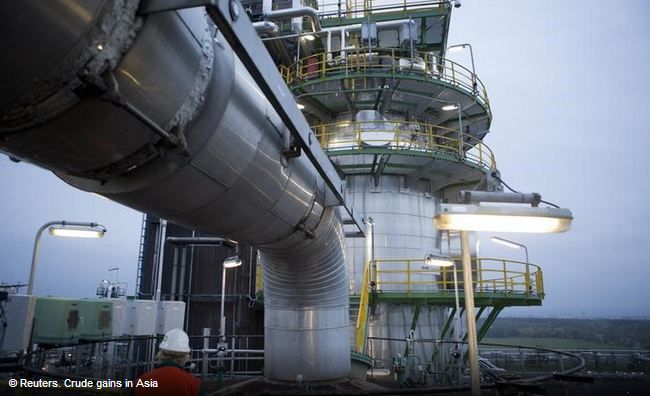Crude gained in Asia on Wednesday as industry estimates showed a much sharper draw in U.S. crude inventories expected, though higher than seen gasoline stocks dimmed sentiment.
On the New York Mercantile Exchange crude futures for June delivery rose 0.72% to $46.21 a barrel, while on London’s Intercontinental Exchange, Brent was last quoted up 0.14% to $49.02 a barrel.
Crude inventories in the U.S. fell a more than expected 5.79 million barrels, the American Petroleum Institute (API) reported in estimates released on Tuesday for the week ended May 5.
Gasoline inventories rose by 3.17 million barrels, compared to a draw expected, and distillate stocks fell by 1.17 million barrels, more than forecast.
Supplies at the oil storage hub at Cushing, Oklahoma, fell by 130,000 barrels.
The API figures are followed on Wednesday by official data from the U.S. Energy Information Administration (EIA). The two sets of data often diverge. Analysts expected crude supplies fell by 1.786 million barrels, with gasoline stocks down by 538,000 barrels and distillate inventories down by 1.013 million barrels.
Overnight, crude futures settled lower on Tuesday, as concerns over rising U.S. oil output returned, after the Energy Information Administration (EIA) raised its near-term outlook for U.S. oil production and revised down its projections for oil prices.
Oil prices pared gains in mid-afternoon trade, as sentiment turned bearish, after the EIA raised its U.S. oil production forecast to an average of 9.3 million barrels per a day (bpd) in 2017 and 10 million bpd in 2018.
The EIA revised down its projection for average oil prices in 2017 to $52.60 a barrel for Brent and $50.68 for WTI.
Crude futures bounced back from a 6% loss sustained in the previous week on Monday, after oil ministers from both Russia and Saudi Arabia said they would consider extending production cuts into 2018.
Russian energy Minister Alexander Novak said on Monday, that a production cut extension for a longer period will help “speed up” market rebalancing while Saudi oil chief Khalid Al-Falih said that he was “confident the agreement will be extended into the second half of year and possibly beyond”.
OPEC is expected to decide at talks on May 25 whether to extend the current deal to cut production for an additional six-months to the end of the year.
In November last year, OPEC and other producers, including Russia agreed to cut output by about 1.8 million barrels per day (bpd).
আশা করি আর্টিকেলটি আপনার ভালো লেগেছে। এই আর্টিকেল সম্পর্কিত বিশেষ কোনও প্রশ্ন থাকলে আমাদের জানাতে পারেন কিংবা নিচে কমেন্ট করতে পারেন। প্রতিদিনের আপডেট ইমেইল এর মাধ্যমে গ্রহনের জন্য, নিউজলেটার সাবস্ক্রাইব করে নিতে পারেন। গুরুত্বপূর্ণ বিষয়গুলো টিউটোরিয়াল দেখার জন্য অনুগ্রহ করে আমাদের ইউটিউব চ্যানেলটি সাবস্ক্রাইব করুন। এছাড়াও, যুক্ত হতে পারেন আমাদের ফেইসবুক এবং টেলিগ্রাম চ্যানেলে। এছারাও ট্রেড শিখার জন্য জন্য আমাদের রয়েছে বিশেষায়িত অনলাইন ট্রেনিং পোর্টাল।

























































